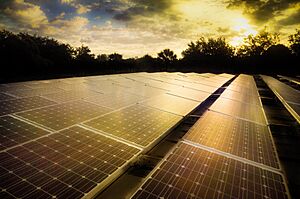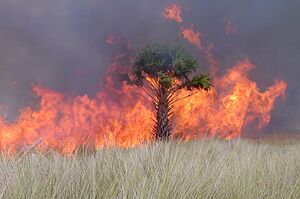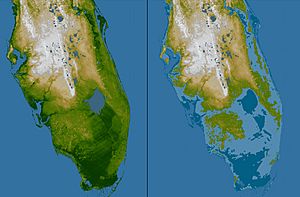Climate change in Florida facts for kids
The effects of climate change in Florida are happening because of more carbon dioxide in the air, mostly from human activities. People in Florida are seeing more flooding as sea levels rise. They also worry about hurricanes becoming stronger or happening more often.
Florida is often called "ground zero" for climate change. This is because many people and businesses are located very close to the low-lying coastlines. More Floridians believe that climate change is happening compared to the national average. As of 2023, about two-thirds of the state thinks that human actions cause climate change. This is up from 55% in 2020.
However, opinions are still divided. Most Democrats agree on the issue. But only about half of Republicans agree and support teaching about climate change in schools. Some Florida communities are trying to deal with climate change. But statewide efforts have been slow because of political disagreements. The focus has been more on being ready for changes (resilience) rather than stopping climate change (mitigation) or fully adjusting to it (adaptation).
Contents
- How Rising Seas Affect Florida
- How Climate Change Affects Florida Hurricanes
- Florida's Climate Change Policies
- How Climate Change Affects Transportation
- How Climate Change Affects Mangroves
- How Climate Change Affects Coastal Real Estate
- Climate Change Education in Florida
- Local Efforts to Fight Climate Change
- South Florida Climate Adaptation Strategies
How Rising Seas Affect Florida

High tides now cause flooding in Miami Beach. The city is spending $500 million to raise roads, build seawalls, and install pumping systems. This is part of their plan to deal with rising sea levels. Maps are available that show areas likely to flood during high tides, storm surges, or major storms.
In Key Largo and Big Pine Key, $517,000 is being spent to raise one mile of roads. This is a pilot project to test ways to handle sea level rise. The Florida Department of Transportation uses a special tool to see how rising seas might affect roads and other transport systems.
Protecting the coast, including adding sand to beaches (beach renourishment), is a main focus for the state government.
A 2018 study from Florida International University warned that rising sea levels will flood the mangrove forests in the Florida Everglades. These mangroves store a lot of carbon, valued at billions of dollars. As the ocean moves further inland, it will affect Miami's drinking water supply. Losing mangroves and wetlands will also harm commercial fishing.
A 2017 study from Cornell University suggested that nearly two million Floridians might have to leave their homes by 2100. This would be due to rising seas caused by climate change.
How Climate Change Affects Florida Hurricanes
Floridians are concerned about changes in how often or how strong hurricanes become. The Climate Change Center at Florida State University and Climate.gov say that the science on hurricane frequency or intensity is not yet clear. However, most climate models predict that rainfall rates during hurricanes will increase. Also, storm surges from hurricanes will get worse with rising sea levels.
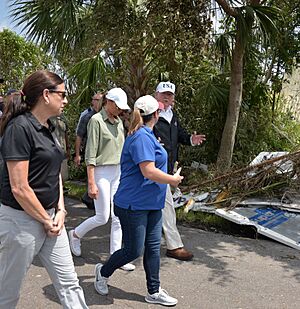
After Hurricane Irma in 2017, Governor Rick Scott did not link changes in hurricane patterns to climate change. This hurricane happened just weeks after Hurricane Harvey.
There is some evidence that hurricanes might slow down. For example, Hurricane Dorian stayed over Grand Bahama Island for a day and a half on its way to Florida.
A Category 5 hurricane is a big worry for the Tampa Bay area. Even a small sea level rise of six inches would make its impact much worse.
The Fifth National Climate Assessment in 2023 reported that coastal states like Florida are seeing "more significant storms and extreme swings in precipitation."
Florida's Climate Change Policies

The Florida Climate Protection Act of 2008 created the Florida Energy and Climate Commission. It also asked the Department of Environmental Protection to create a plan to reduce greenhouse gases.
When Governor Charlie Crist took office, he signed several orders about climate change. These orders included limits on car emissions and goals to reduce the state's greenhouse gas emissions. He also required Florida's electric companies to use at least 20 percent renewable energy by 2020. Under Crist, six new coal-fired power plants were not approved.
Governor Rick Scott did not believe in human-caused global warming during his first election in 2010. His administration discouraged using the term "climate change." He also removed rules to reduce greenhouse gas emissions. He appointed people who doubted climate change to important positions. Scott also vetoed money meant for pumping water out of Miami Beach. He said the money did not show a clear benefit for the whole state. A group of children aged 10-20 even sued Scott over his climate policies.
Governor Ron DeSantis created an Office of Resiliency and Coastal Protection. DeSantis did use the words "climate change" in a statement. He said his environmental policy was to do things that help Floridians. However, DeSantis has not made stopping climate change or increasing renewable energy a main goal. In 2020, the Sierra Club of Florida gave him a D grade for his environmental work.
Republican politicians in Florida often focus on preparing for climate impacts (resilience) rather than preventing climate change. However, some South Florida Republicans, like Miami-Dade County Mayor Carlos Giménez, believe that human-caused climate change is real and serious.
Florida State Senator José Javier Rodriguez has tried to highlight the problem of sunny day flooding. He sometimes wears black rainboots during legislative meetings to draw attention to it.
In May 2024, Governor Ron DeSantis signed a law that removed several mentions of climate change from state laws. It also removed greenhouse gas reduction as an energy priority. The law banned offshore wind turbines and weakened rules on natural gas pipelines. It also stopped cities from banning appliances like gas stoves.
Public Opinion on Climate Change
The "Energy Poll" from the University of Texas at Austin found that 63% of Floridians believed climate change was happening in 2012. By 2016, this number rose to 81%. A 2020 survey by Florida Atlantic University (FAU) found that over two-thirds of Floridians worried about climate change's impact on the state's future.
In 2023, FAU's "Florida Climate Resilience Survey" showed that 65% of people, including 49% of Republicans, believe human activity mainly causes climate change.
How Climate Change Affects Transportation
The Florida Department of Transportation has looked at how to measure greenhouse gas emissions from transportation. They also study how rising sea levels might affect roads and other transport systems.
How Climate Change Affects Mangroves
Mangrove forests in the Everglades are threatened by rising sea levels. However, mangroves are also spreading north. This is because storms carry their seeds, and there haven't been hard freezes in Northeast Florida for 30 years that would kill them.
Mangroves are very important for storing carbon, sometimes called "blue carbon." The carbon stored in Everglades mangroves is estimated to be worth billions of dollars.
Mangroves also help control floods and protect against storms. They create a flood barrier during storms, protecting other trees. Mangroves also help build up soil, which keeps the coastline higher.
Harmful red tides, which hurt the economy, are expected to continue. This is due to pollution and warming waters.
How Climate Change Affects Coastal Real Estate
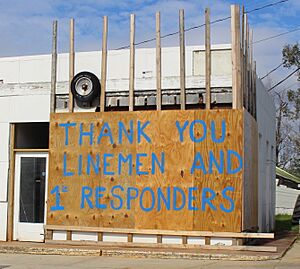
In 2017, the real estate website Zillow predicted that if climate forecasts are right, by 2100, one in eight Florida homes would be underwater. This would account for almost half of the lost housing value across the U.S. This prediction was based on comparing maps of a 6-foot sea level rise with Zillow's home database.
The real estate website Curbed has listed Florida cities, homes at risk, and estimated dollar values. Curbed estimated that about 64,000 homes, including 12,000 in Miami Beach, will face regular flooding. They also said changes are needed in the National Flood Insurance Program. Another firm, Jupiter Intelligence, suggests that extreme flooding could affect 86% of Miami-Dade's homes by 2030, up from 5%.
A 2018 report by the Union of Concerned Scientists said Florida has the most homes at risk from climate change. About 1 million homes, over 10% of the state's current homes, are in danger.
Officials in the Florida Keys found that saving just three miles of road serving about two dozen homes would cost $75 million. A 2019 New York Times article about decisions in Monroe County was titled, "Florida Keys Deliver a Hard Message: As Seas Rise, Some Places Can't Be Saved." Some small islands in the Keys might disappear completely.
"Climate gentrification" is also happening in Miami. This means real estate values are increasing in higher-elevation areas. At the same time, values are decreasing in lower-lying areas. By 2017, two historically lower-income neighborhoods, Little Haiti and Liberty City, became more attractive to investors because they are on higher ground. Home prices grew more slowly in 2018 in Miami Beach and other low-lying parts of Miami-Dade County.
One company that assesses flood risk says the South Florida housing market is kept afloat by people not telling buyers about flood risks. A bill to require real estate agents to share flood risks passed the U.S. House, but not the Senate, as of 2019.
Climate Change Education in Florida

Florida's education standard for climate change states: "Identify, analyze, and relate the internal (earth system) and external (astronomical) conditions that contribute to global climate change." This standard is not as strong as the Next Generation Science Standards adopted by many other states. The human causes of climate change are treated "as an aside," according to a leader with the Alliance for Climate Education.
Local Efforts to Fight Climate Change
Miami-Dade County has built seawalls and has a plan to reduce carbon dioxide. It also works with the South Florida Regional Climate Compact. Miami Mayor Francis Suarez has promised to make the city carbon neutral by 2050.
Pensacola has created a Climate Mitigation and Adaptation Task Force that meets every month.
Orlando Mayor Buddy Dyer was one of the first mayors to sign the Climate Mayors' Pledge. Orlando plans to switch its city vehicle fleet to alternative fuels by 2030.
Sarasota's Climate Adaption and Mitigation Center works to gather scientific information. This helps academics, government, and businesses make decisions.
In North Central Florida, where some people are more skeptical about climate change, efforts started to be seen in 2020. This includes Gainesville, Alachua County, St. Augustine, and Jacksonville.
In Broward County's Oakland Park, new drainage systems helped prevent damage to 400 homes during Hurricane Irma.
Coral Gables Mayor Jim Cason has said, "We're working hard to create solutions until we inevitably must retreat."
South Florida Climate Adaptation Strategies
Climate Journalism
The South Florida Sun Sentinel, Miami Herald, and Palm Beach Post, along with WLRN Public Media, have teamed up to cover climate change. They provide news and features, and have a website called The Invading Sea, Florida and the Climate Crisis.
Southeast Florida Regional Climate Compact
The Southeast Florida Regional Climate Compact is a partnership between Broward, Miami-Dade, Monroe, and Palm Beach Counties. Their goal is to work together to reduce greenhouse gas emissions. They also aim to put adaptation plans into action and build climate resilience.
Integrative Collaborative on Climate and Energy (ICCE)
The Florida Center for Environmental Studies at Florida Atlantic University created the Integrative Collaborative on Climate and Energy (ICCE). This group focuses on how Florida's cities and natural areas can adapt to climate change. Partners include the Florida Climate Initiative and the University of South Florida.
Miami-Dade County Climate Programs
Miami is often called "ground zero" for climate change and sea level rise. The Miami-Dade County Office of Resilience has climate programs and a Climate Action Plan. There is also a Sea Level Rise Committee. Protecting the water supply and the Biscayne Aquifer is a top priority.
|




